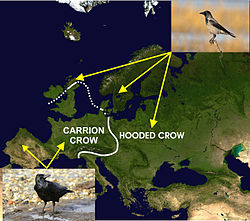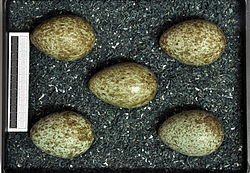Carrion crow
The carrion crow (Corvus corone) is a type of crow found in east Asia, and in parts of western Europe. Nests are usually in trees and sometimes old buildings, Young birds get wings about a month after birth.[1][2][3][4][5][6] This crow is not in any danger, and is of least concern.[7]
Carrion Crow Media
Bird recorded in Devon, England
Adult male carrion crow moulting at the Jardin des Plantes of Paris
A map of Europe indicating the distribution of the carrion and hooded crows on either side of a contact zone (white line) separating the two species
In Southend-on-Sea, England
Eggs, Collection Museum Wiesbaden
The carrion crow can be seen performing bowing gestures while cawing.
Other vocalizations of the carrion crow include clicking.
References
- ↑ "Carrion Crow". Animal Diversity Web.
- ↑ Pettifor, Richard A. (1990). "The effects of avian mobbing on a potential predator, the European kestrel, Falco tinnunculus". Animal Behaviour. 39 (5): 821–827. doi:10.1016/S0003-3472(05)80945-5. S2CID 53200478.
- ↑ "Carrion Crows Can Volitionally Control Their Calls, Researchers Say | Biology | Sci-News.com". Breaking Science News | Sci-News.com. 28 August 2019. Retrieved 2019-12-29.
- ↑ New general licence for controlling carrion crows comes into force. https://www.gov.uk/government/news/new-general-licence-for-controlling-carrion-crows-comes-into-force.
- ↑ Researchers study corvid speciation in restricted zone where crow hybrids thrive. https://phys.org/news/2019-03-corvid-speciation-restricted-zone-crow.html.
- ↑ Baglione, V.; Marcos, J. M.; Canestrari, D.; Ekman, J. (2002). "Direct fitness benefits of group living in a complex cooperative society of carrion crows, Corvus corone corone". Animal Behaviour. 64 (6): 887–893. doi:10.1006/anbe.2002.2007. S2CID 53200940.
- ↑ "Corvus corone (Carrion Crow)".







